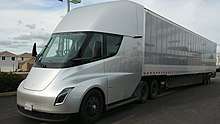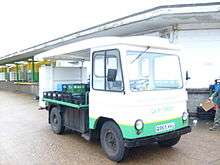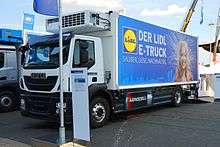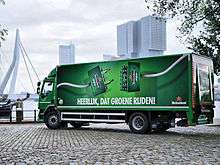Electric truck

An electric truck is an electric vehicle powered by batteries designed to deliver cargo.
Electric trucks have been around in niche application areas for over a hundred years, but more recently the advent of lithium ion batteries has enabled the range of electric trucks to increase to several hundred miles, making them of much wider applicability.
Electric trucks are becoming a cheaper alternative to traditional trucks, while creating no local pollution. Due to the very high efficiency of electric power trains, running costs are much lower, while purchase cost is (as of 2018) similar or slightly higher. Due to their simplicity, maintenance costs are also much lower.
However, electric trucks are usually heavier than diesel trucks, the energy density of lithium ion batteries is far less, so very long range trucking requires recharging en-route, causing delays, or the swapping of tractor units.
Types
General trucks
In 2011, GGT Electric, an automotive engineering, design and manufacturing company[1] based in Milford, Michigan, introduced a new line of all-electric trucks for sale. GGT has developed LSV zero-emission electric vehicles for fleet markets, municipalities, universities, and state and federal government. The company offers 4-door electric pick-up trucks,[2] electric passenger vans, and flatbed electric trucks with tilt and dump capability.[3]
In 2012, Motiv Power Systems announced its electric powertrain control system (ePCS) could be scaled to power any type of truck, from shuttle buses and Class-A school buses, to work trucks, box trucks, and even 52,000 lb (24,000 kg) garbage trucks. The Motiv kit can be used with almost any new truck maker’s chassis or for an older truck retrofit. Motiv collaborates with existing truck manufacturers to allow them to sell electric options to their existing customers.
Pickup trucks
In early 2009, Phoenix Motorcars introduced a test fleet of their all-electric SUT (Sports Utility Truck) to Maui. One of the surviving electric vehicles from the late 1990s is the Chevy S-10 electric pickup truck. Many other vehicles from this era, such as the General Motors EV1 were recalled and destroyed. A newcomer is the Miles Electric Vehicles ZX40ST electric truck, now available in the United States. Miles Electric Vehicles is based in Santa Monica, California.[4]
The Big Bike Company Limited, in Gloucestershire, England, is now offering fully electric pick up trucks for sale. Powered by an impressive bank of batteries, these small utility vehicles are able to deliver a payload of approximately 500 kg (1,100 lb), and have a range of up to 80 miles (130 km). Using a 3-wheel configuration, the rolling and aerodynamic drag is reduced. As a tricycle it can also be driven on a motorcycle licence.
Semi-trailer and tractor trucks
The Port of Los Angeles and South Coast Air Quality Management District have demonstrated a short-range heavy-duty all-electric truck capable of hauling a fully loaded 40-foot (12.2 m) cargo container. The current design is capable of pulling a 60,000 lb (27,000 kg) cargo container at speeds up to 10 mph (16 km/h) and has a range of between 30 and 60 miles (48 and 97 km). It uses 2 kilowatt-hours per mile (1.2 kW⋅h/km; 4.5 MJ/km), compared to 5 miles per US gallon (47 L/100 km; 6.0 mpg‑imp) for the hostler semi tractors it replaces.[5]
1 U.S. gallon (0.83 imperial gallons; 3.8 liters) of fuel is equivalent to =33.7kwh, according to the US Department of Energy.[6] This electric truck uses 2 kilowatt-hours per mile which is the equivalent of using only 10 kwh per every 5 miles (8 km). The diesel truck that it replaces uses the equivalent of 33.7kwh per 5 miles (8 km). Thus the diesel truck is using 3.37 times the amount of energy that the electric truck is using. Thus the only variables that are stopping commercial use of electric trucks are original vehicle cost and the driving range, owing to the high battery pack cost and low specific energy[7]. As mass production happens the cost might eventually be comparable to diesel vehicles and with improvement in batteries the limited range of the electric truck might be a non issue.
Electric tractors
Electric tractors have been built since the 1990s.[8][9][10] BYD does make electric tractors.[11]
Milk float

A common example of the battery electric trucks is the milk float. Since it makes many stops in delivering milk it is more practical to use an electric vehicle than a combustion truck, which would be idling much of the time; it also reduces noise in residential areas. For most of the 20th century, the majority of the world's battery electric road vehicles were British milk floats.[12]
Garbage truck
With a similar driving pattern of a delivery vehicle like the milk float above, garbage trucks are excellent candidates for electric drive. Most of their time is spent stopping, starting or idling. These activities are where internal combustion engines are their least efficient. These and other factors such as ease of driver training resulted in Birmingham City Council opting to use electric dustcarts to start replacing its horse driven carts in 1918.[13] Its use of electric vehicles continued through a number of models including DV4s until 1971.[13][14] Electric Dustcarts were also operated by Sheffield and Glasgow.[15]
In preparation for the 2008 Olympic Games, 3,000 of the internal combustion engine garbage trucks in Beijing were replaced with lithium ion polymer battery pack electric drive trucks.[16] The batteries were procured for about $3,300 each.[17] In France, some all-electric garbage trucks produced by Power Vehicle Innovation have been operating since 2011 in the city of Courbevoie, the first local authorities in France to acquired them.[18]
In 2014, North America became home to its own electric garbage truck. Called the ERV (electric refuse vehicle) it hit the road in Chicago in September 2014. It was the first of an up to $13.4 million purchase order for up to 20 trucks. The PO was won in a competitive bid by Motiv Power Systems in 2012. The majority of the money used to purchase the first truck came from a DoE grant secured by then-Senator Barack Obama. The City of Chicago runs the Motiv ERV on different residential refuse and recycling routes of up to 60 miles, saving 2,688 gallons a year.

Chicago specified that this ERV must meet the demanding requirements placed on all of its garbage trucks. This included 60 mile range, a payload capacity of nine tons and 1000 pounds per cubic yard of compaction. These specifications make the ERV capable of use anywhere in Chicago. To supply enough electricity to move the truck and power the hydraulics all day, the ERV is equipped with 200 kilowatt-hours of energy, in ten battery packs. Full charge time is 8 hours using the Motiv Universal Fast Charger.
Wrightspeed provides electric powertrain for garbage trucks and other medium-duty trucks.
Off-road and mining truck
In 2011, PapaBravo Innovations, an electric vehicle design, manufacturing and engineering company based in Saskatoon, Saskatchewan, Canada introduced a full line of heavy-duty underground mining trucks. These off-road 4x4 trucks are the first of their kind; a one-ton platform with full-time 4-wheel-drive capability. They have been designed specifically for "soft-rock" underground mining industries. The line of electric trucks ranges from 1/4-ton utility vehicles to 1-ton trucks and a 12-passenger personnel transport vehicle.
Newton
Launched in 2006, the Newton electric truck is an all-electric commercial vehicle from Smith Electric Vehicles. The Newton comes in three GVW configurations: 7,500 pounds (3,400 kg), 10,000 pounds (4,500 kg) and 12,000 pounds (5,400 kg). Each is available in short, medium or long wheelbase.
The truck was launched with a 120 kilowatt electric induction motor from Enova Systems, driven by Lithium-Ion Iron Phosphate batteries supplied by Valence Technology. In 2012 Smith re-released the Newton with new driveline and battery systems that were developed inhouse. Smith offers the battery pack in either 80kWh or 120kWh configurations.
Newton was named Green Commercial of the Year in the electric vehicle section of Fleet Transport magazine’s Irish Truck of the Year Awards 2010, sponsored by Castrol.[19]
As of October 2012, the Newton is sold worldwide and available with three different payload capacities from 6,100 to 16,200 lb (2,800 to 7,300 kg).[20] The lithium-ion battery pack is available in varying sizes that deliver a range from 55 to 110 mi (89 to 177 km) and a top speed of 50 mph (80 km/h).
E-Force One

Since January 2014, COOP Switzerland operates in the region of Zurich a 18 t truck with electric drive. 18 square meters of photovoltaic elements on the truck roof support the battery operation in addition.[21] The truck has a capacity of 300 kW. The solar panels on the roof of the truck along with the recuperation provides 23 percent of the total energy of the vehicle. The range of the truck is 240 km per day. The energy consumption is 130 kWh per 100 km and after deduction of the energy from the solar system and recuperation, it is about 100 kWh per 100 km. A comparable diesel engine consumes about three times as much energy. The industry association Euro Solar European Solar Prize 2014 awarded in the category transport and mobility to Coop for the use of this electric truck.[22] The truck, which the Swiss company E-FORCE had developed ONE AG weighs eight tons, has a gross vehicle weight of 18 tonnes and costs 380,000 Swiss francs. It is about twice as expensive as a diesel version of the truck. The truck is based on an Iveco Stralis chassis. The converted in cash consumption is 10 francs per 100 kilometers, with a diesel truck is 50 francs. According to Coop, the vehicle had a comparable diesel truck emissions concerning superior and equal in the economy. The truck has two LiFePO4 batteries with a capacity of 120 kWh with a weight of 1300 kg. The battery can be replaced within 10 minutes.
The truck E-Force One won the 2014 German Federal Ecodesign.[23]
Two vehicles of this electric truck coming since mid-2014 even at Lidl in Switzerland [24] and a truck at the Feldschlösschen Beverages Ltd. are used.[25] Since June 2015, such a vehicle at the company Pistor, Switzerland is in use.[26] Even the shipping company Meyer logistics uses such refrigerated trucks in Berlin. The truck consumes an average of 88 kWh per 100 kilometers when used on the tours to city, intercity and highway routes. The company achieved energy savings by two-thirds compared to a diesel truck. The maintenance and the service life are not higher than a comparable diesel truck. The company wants to use other vehicles of this type.[27]
Emoss

From 2012, the eight Dutch companies 2 switch, 020stads distributie, DeRooy, Deudekom, Heineken, Mondial Movers, Sligro and TopMovers each took a 100% electric truck with the name "Hytruck" in operation.[28] All trucks are customized solutions with different payloads (up to 10 tonnes), batteries and packages range (150–200 km).[29] The Dutch company Emoss Mobile was system for the production B.V. responsible from Oosterhout: (Emoss short).[30] Among them was a 19-ton electric motor truck of Heineken with 9-tonne payload and 200 km range.[31] With the use of which can be saved annually around 22 tons of CO2 and the emission of sulfur oxides SOx and nitrogen oxides NOx is suppressed.[31] The last truck was delivered in July, 2014. Since autumn 2014, the Swiss company acts as a general agent of CEEkon AG Emoss in Switzerland, Austria and Lichtenstein.[32]
In August 2013 the German discounter TEDi integrated a 12-ton Emoss electric motor truck in its fleet to supply several stores in North Rhine-Westphalia. The range is about 200 km, but thanks to opportunity charging a daily use profile of 300 to 400 km at one charge can be obtained.[33]
On 22 May 2015 Emoss celebrated the introduction of a 19-ton electric motor truck (based MAN TGM) with cooling assembly and 10-ton trailer in a world premiere. The electric truck is used by Lidl Holland for goods distribution in the city center of Amsterdam. That means that up to 90 tons of CO2 per 100 km, can be saved. The 250 kW electric motor use LiFePO4 batteries with a capacity of 200 kWh, which are charged in less than 5 hours.[34]
On June 29, 2015, the company Niinivirta put a 16-tonne Emoss electric truck company into operation for the distribution of goods in Tampere (Finland). The Emoss CM1616 (base DAF LF55) has a 250 kW engine with an instant torque of 2700 Nm and 7 tons of payload. The LiFePO4 batteries have a total capacity of 160 kWh and are protected from the very cold conditions by a special isolation device. With a Fast Charger full charging takes only 3.5 hours.[35]
Terberg
BMW Group has commissioned an electrically powered 40-ton truck for transporting material on public roads. The vehicle comes from the Dutch manufacturer Terberg and commutes eight times a day between a logistics center and the Munich BMW plant. The truck battery takes three to four hours to charge. When fully charged, the vehicle has a range of up to 100 kilometres. Thus, the electric truck can theoretically complete a full production day without any additional recharging. Compared to a diesel engine truck, the electric truck will save 11.8 tons of CO2 annually.[36][37]
Haul truck
The company Lithium Storage GmbH is building together with the company Kuhn Switzerland AG a battery-powered haul truck. The vehicle is to go the end of 2016 in operation. The dump truck weighs 110 tons. The chassis is a Komatsu 605-7. The vehicles have an electric motor with 800 hp and can thus produce 5900 Nm. The battery is a 600 kWh lithium-ion battery. For comparison, diesel vehicles of this type consume approximately 50,000 to 100,000 liters of diesel per year.[38]
eHighway
In 2018, Siemens and the South Coast Air Quality Management District have launched an electrified highway demonstration project near the Los Angeles Port and Long Beach Port, using overhead lines to supply the trucks with electrical power instead of relying on onboard batteries.[39]
See also
- Battery electric bus
- Battery electric vehicle
- CalCars
- CarGoTram
- Charging station
- E-FORCE ONE
- Electric vehicle conversion
- Ground support equipment
- Hybrid electric truck
- Modec
- North American Council for Freight Efficiency
- Smith Electric Vehicles
- Solar-charged vehicle
- Trolleytruck
- VIA Motors
- Wrightspeed
- TransPower
References
- ↑ Jim Motavalli, Jim. "Starting an EV Company with 10 People, $5 Million and Chinese Suppliers". BNet.com. Retrieved July 30, 2009.
- ↑ "GGT Electric E-Dyne 4-Door Cab Crew Truck". GGT Electric. Archived from the original on 4 June 2011. Retrieved 24 May 2011.
- ↑ "GGT Electric Scout Hybrid Trucks". GGT Electric. Archived from the original on 17 August 2011. Retrieved 24 May 2011.
- ↑ David Levine (June 17, 2009). "Creating a Buzz; A Sullivan County firm leads the way by selling alternative-power cars and trucks". Hudson Valley. Retrieved March 11, 2012.
- ↑ Theresa Adams Lopez (2008). "Electric Truck Demonstration Project Fact Sheet" (PDF). Port of Los Angeles. Retrieved 2009-01-04.
- ↑ http://www.fueleconomy.gov/feg/Find.do?action=phev1Prompt
- ↑ Sripad, Shashank; Viswanathan, Venkatasubramanian (2017). "Performance Metrics Required of Next-Generation Batteries to Make a Practical Electric Semi Truck". Acs Energy Letters. 2 (7): 1669–1673. doi:10.1021/acsenergylett.7b00432.
- ↑ "Electric tractors". Renewables.com. 2009-06-08. Retrieved 2010-11-27.
- ↑ Steve Heckeroth's tractors
- ↑ "Yanmar tractor conversion". Evalbum.com. 2005-12-30. Retrieved 2010-11-27.
- ↑ BYD (May 9, 2017). "BYD INTRODUCES CLASS 8 BATTERY-ELECTRIC REFUSE TRUCK FOR NORTH AMERICAN MARKET". BYD.
- ↑ "Escaping Lock-in: the Case of the Electric Vehicle". Cgl.uwaterloo.ca. Retrieved 2010-11-27.
- 1 2 De Boer, Roger F (1990). Birmingham's Electric Dustcarts. Birmingham & Midland Motor Omnibus Trust. pp. 8–10. ISBN 978-0905586076.
- ↑ De Boer, Roger F (1990). Birmingham's Electric Dustcarts. Birmingham & Midland Motor Omnibus Trust. p. 21. ISBN 978-0905586076.
- ↑ De Boer, Roger F (1990). Birmingham's Electric Dustcarts. Birmingham & Midland Motor Omnibus Trust. p. 25. ISBN 978-0905586076.
- ↑ "Electric Drive Garbage Trucks in Beijing". Jcwinnie.biz. Archived from the original on 2010-10-17. Retrieved 2010-11-27.
- ↑ "Advanced Battery Technologies, Inc. Signs Contract to Supply PLI Battery Cells for Electric Sanitation Trucks for 2008 Olympics". Marketwire.com. Retrieved 2010-11-27.
- ↑ Sage, Alexandria (2011-05-05). "All-electric garbage trucks to sweep French streets". Reuters.
- ↑ "Smith Electric Vehicles - News". Smithelectricvehicles.com. Retrieved 2010-06-08.
- ↑ Smith Electric Vehicles. "SMITH VEHICLES - Models and Configurations". Smith Electric. Retrieved 2012-10-08.
- ↑ Elektro-Lastwagen von Coop erhält Auszeichnung auf coop.ch, 23. Mai 2014.
- ↑ Eurosolar verleiht Solarpreise auf photovoltaik.eu, 26. November 2014.
- ↑ E-Force One gewinnt deutschen Bundespreis Ecodesign 2014, 15. November 2014
- ↑ 20min.ch Detailhändler setzen auf Elektro-Lastwagen, 20. August 2014.
- ↑ elektromobilclub.ch Neuer 18-Tonnen-Elektro-Lastwagen in der Schweiz vorgestellt, 17. Juli 2014
- ↑ Pistor nimmt Elektro-Lastwagen in Betrieb, 25. Juni 2015
- ↑ Elektro-Lkw überzeugen im Praxistest, 17. November 2015
- ↑ "Hytruck" (in Dutch). Retrieved 2016-03-09.
- ↑ "Emoss successful-conclusion" (in German). Retrieved 2016-03-09.
- ↑ "Emoss" (in German). Retrieved 2016-03-09.
- 1 2 "Elektrolastwagen Heineken" (in German). Retrieved 2016-03-09.
- ↑ "ceekon" (in German). Retrieved 2016-03-09.
- ↑ "Emoss CM1220" (in German). Retrieved 2016-03-09.
- ↑ "Emoss CM1820" (in German). Retrieved 2016-03-09.
- ↑ "16-Tonnen Elektrolastwagen von Emoss in Finnland" (in German). Retrieved 2016-03-09.
- ↑ http://www.golem.de/news/40-tonner-bmw-nimmt-schweren-elektro-lkw-in-betrieb-1507-115151.html retrieved on July 10, 2015
- ↑ https://www.scherm.com/newsroom/252-elkw-offizielle-inbetriebnahme abgerufen am 10. Juli 2015
- ↑ "Das weltweit grösste Elektrofahrzeug fährt demnächst in der Schweiz" (in German). 2016-03-12. Retrieved 2016-03-14.
- ↑ https://insideevs.com/first-u-s-ehighway-launched-in-california-by-siemens/
External links
| Wikimedia Commons has media related to Electrically powered trucks. |